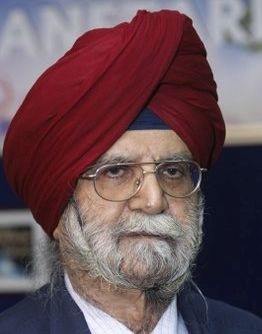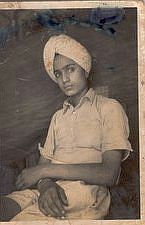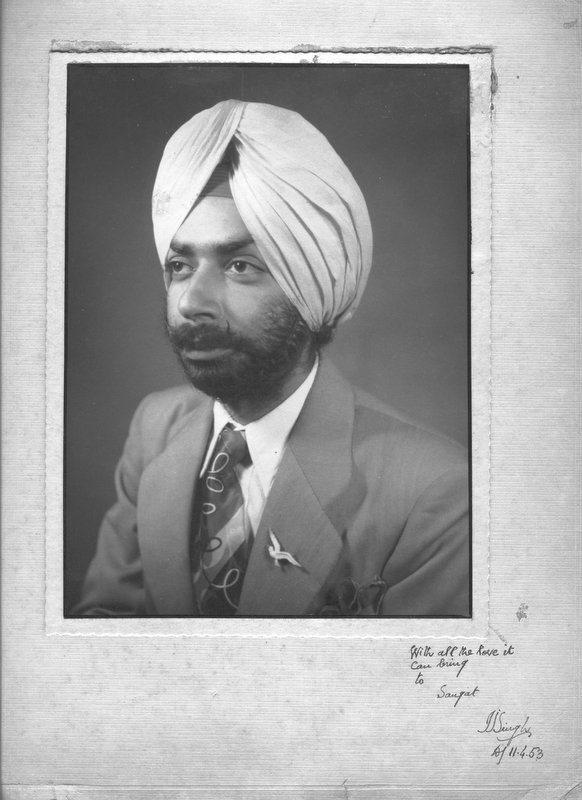Latest Contributions
Read More Contributions
My 1947 Box Camera Selfie
Category:
Tags:

Born in 1933 in Dijkot, a small hamlet in district Lyallpur (now Faisalabad, Pakistan), I came after about eight attempts, including miscarriages. I grew up in Lyallpur as a pampered child. At the age of five, I was sent to nearby one roomed primary school where spartan old Jute Hessian bags (borian) were used for mats. I refused to study there, and was enrolled in Sacred Heart Convent School for the next 9 years. After getting his college degree in India, he moved to Singapore in 1954, and then to Malaysia in 1957, where he worked for Guthrie &\; Co., a large Scottish plantation company. He retired in 1988. He lives in Malaysia with his wife. More about him at this link.
Lyallpur
In 1947, my family lived in Lyallpur before shifting to India at the time of partition.
Even though I was only 14 years old, I had become deeply interested in photography. By then I had already learned how to develop and print pictures.
My first photography Guru was Lat of Lat Photo just opposite Jatinder Ji's house in Goal Bazar that was also mentioned by Jatinder Ji in My Memories of Lyallpur.
Once, I sold some second hand books to a book seller in Aminpur Bazar. This shop was located just opposite the Desi Sharab da Thayka shop, which sold Desi Sharab (alcoholic drinks made in India.) The liquor shop had a notice in Urdu that read Sharab pee kar khali bottle ederh chorni para ga (You must return empty bottles here). World War II had just finished, and empty bottles were in short supply. They were sold for one or two rupees each.
The bookseller paid me about Rs. 7/- This was a lot of money in those days!
With this money in my pocket, I went straight to the famous photographer in Katcherry Bazar, He had a motor cycle with a side car, and always wore a black topi (cap). I bought a Kodak box camera, which became available after World War II, from him for Rs. 6 and 12 Annas (16 annas = 1 rupee). This left me with 4 annas to spend on something else!
The film I used was the 120 Kodak roll, which took only 8 pictures. The rolls were in short supply. Lat was the most innovative person I ever knew. He took some rolls of surplus aerial film, and started to cut and repack it in empty 120 Kodak rolls, which were normally thrown away after the film was developed. Lat Sahib announced that he would buy those discarded rolls, for, I think, 4 annas each. For a while, we used those repacked discarded rolls
With this Box Camera, I took what is now known as a selfie - a photo of myself that has been with me all this time! How was this photo taken? I set up my Kodak box camera on a table, and got my youngest sister Jindi, then 9 years old, to press the button.

Sangat Singh, 1947. Lyallpur. Self-portrait with a Kodak box camera
I had installed myself as Lat's unpaid assistant. I swept his studio, helped his wife to buy vegetables and milk, wiped the baby's nose to endear myself. I paid amply this little price to learn every bit about photography. Soon I was doing all the developing and enlarging jobs for him.
Now here is a story that I had kept as a secret to this day, and never even shared with anybody.
One afternoon, in the month of June 1947, a customer walked in to have his film from Kashmir trip processed. I promptly went into the dark room and stated to develop the film. It was so hot that the film just melted in my hand. The whole emulsion came off. I had just ruined the film!
I badly needed to escape Lat Sahib's ire. I quickly found a completely foggy film in the darkroom, and just put in the developer. I brought the wet film to show the customer, who was still waiting anxiously, and sternly told him: "Don't you know photography? The whole film was completely out of focus." This is the first time I have unburdened this confession!
Later on I started my own side business and offered to develop films and print at half the price.
Let me share with you some photography related stories from Lyallpur.
Lyallpur's Bhowana Bazar had a ‘Tent House' named Gian Singh Trilok Singh. Apart from providing tents for various get-togethers, it was also famous for selling crackers and large variety of other fireworks like sparklers and vicious Krishan Bombs, which they sold once a year during Diwali festival. Trilok Singh was the eldest son who helped in the business. Next in line was Mohan, a tall stammering lout of about 13 years, who was still in his long single Guth (plait).
Mohan was very keen to learn about developing and printing. He pestered me constantly. In those days you had to make your own developer by mixing into distilled water chemicals like Metol, Sodium Sulphite, Hydroquinone, and Potassium Bromide, etc. It was clearly beyond his ability to concoct such a complicated mixture.
I relented for a small price. He supplied me with an empty Desi Sharab bottle from his father's inventory. We half-filled the bottle with developer. Then, he promptly put back the bottle in his father's bar.
It was his father's habit to pour himself a stiff peg of whiskey with Soda Water. Unfortunately, that particular evening, it tasted vastly different. He shouted, Oye Mohan Ulu thay Pathay" (An innocuous all-purpose Punjabi invective), what have you poured in this bottle?"
"Bau Ji," he stammered, "It is developer!" He ran to our nearby house, shouting at the top of his voice that his father had taken developer and was he was going to die. He asked me, "What do I do now?" I told him the next step in developing was to give a drink of Hypo solution that was used to fix the film. The father survived but Mohan received one heck of a thrashing that ended his career as a photographer.
In 1946, just before he retired, the Governor of Punjab, Sir Bertrand Glancy, came to Lyallpur for a brief visit. A Nambardar (village headman) of a nearby village came to Lat's studio. He requested Lat and requested him to take a picture of the Nambardar shaking hands with the Governor.
Equipped with his field camera, Lat arrived at the scene on the appointed day. However, the Governor did not shake hands with the Nambardar. When the Governor was about to get in his car to leave the place, the Nambardar rushed to him, and said in chaste Punjabi, "Sahib Ji mor hath cha melavo na ji (Please, Sahib allow me to shake your hand as I had arranged a photographer at great expense to record that special event.) Sir Glancy readily agreed, and Lat took the photo. That special picture was prominently displayed by Lat in his studio showcase. I remember clearly it was there when we left Lyallpur in 1947. (There used to be a beautiful Glancy Park next to the famous Company Bagh. I believe it is still there)
Then came the Partition in August 1947.
I lost my camera and the darkroom, but I carried the skill with me to India
After Lyallpur
For a brief spell, photography became my profession. I opened a photography studio known as Rakesh Studio on Raykhi Road, Ludhiana, in partnership with Mr. N. P Dhanda. The arrangement did not last because I was offering free service to some of my chosen friends.
My portrait of my dear friend Inderjit Singh broke the camel's back. It was now clear that I had little future as a business man. Inderjit still claims credit to this day for all my subsequent successes because it was he was responsible for getting me fired!
I still have that (in)famous photo!

Inderjit Singh 1953. Ludhiana.
Soon after being fired in Ludhiana, I arrived in Singapore in 1954. My first investment was to buy a Rolleicord Twin Lens Reflex Camera, Enlarger and other darkroom equipment. Soon, I was making some waves. Between 1954 to 1957, I won some twenty plus first prizes and had my work published in UK's Sphere and Punch magazines. My pictures also appeared in Far Eastern Economic Review and various other places.
But, while I could take good pictures, it became clear that it could not be my career. In 1957, I started working at a plantation in what was Malaya at that time.
© Sangat Singh 2016
Comments
Add new comment